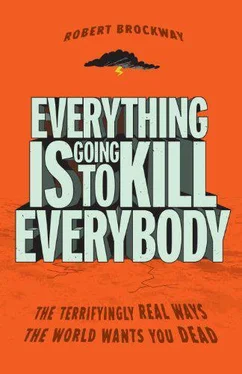Transcript from Development Meeting of Nanotube Shape Deciders
“Listen, guys, I love this tiny shit we’re doing here, but I’ve got an idea and I’m just gonna throw it out there: Let’s make ’em long, straight, thin filaments—like asbestos!”
“But sir, is it really the best idea to model our product after a deadly carcinogen?”
“You know what else is a deadly carcinogen? Your butt! Ho! Served!”
“Well played, sir. Cancer tubes it is.”
Concerns are also being raised about interaction between nanoscale products and external factors. Even if the nanotech itself is totally safe, if it meets up with the wrong stuff inside your body, all hell breaks loose. It’s like this: Say you have a lovely, pure, angelic daughter. She’s very talented, well-spoken, and a pleasure to be around. She’s the light of your life. But one day she brings home her new boyfriend to meet the folks… and he’s a rabid grizzly bear. Now, your daughter is still an angel in her natural environment (your home) and a grizzly bear is a noble, majestic creature in its home (the wild), but when you bring the two together, it tends to fuck up the family reunion. Now replace the family reunion in that metaphor with your own sweet internal organs, and you’ve got a delicious terror sauce that pairs well with both anxiety and horror!
Take gallium arsenide, for example: It’s just a harmless semiconductor, kind of like a faster version of silicon. It’s already all over many small-scale electronics and solar panels, but if you deploy it at the nano scale, suddenly it starts seeping into your body. And that’s when shit really goes wrong, because gallium arsenide is made from gallium… and arsenic! You know, like the deadly poison? So yes, gallium arsenide is a completely safe tool on the normal scale, but if it starts actually getting inside your body, you might have some problems, and deadly, poisonous problems are among the shittiest genre of problems to have inflicted on every cell in your body. That risk is not inherent to just gallium arsenide, either; pretty much any material could, theoretically, have that ill effect when brought to the micro scale. A toaster, for example, is a lovely machine—who doesn’t love its warm, crispy ejaculations? But if you shrink that toaster down to the nano scale, well, suddenly it’s a different story when that comforting, crusty breakfast staple is being made a billion times a second inside your own heart .
Terror Sauce Wine Pairing Guide
• Red meat + terror sauce = pinot noir
• Fish + terror sauce = chardonnay
• Spiders + terror sauce = tears
• Clowns + terror sauce = nightmares
• Spider clowns + terror sauce = nocturnal fear emissions
And it’s not like you can just opt out of it, either, because this seepage factor means it won’t affect only the voluntary users of nanotech. A core principle of effective nanotechnology, after all, is the ability to spread in anything from bodily fluids to simple skin contact, through our food supply, or even as airborne contaminants. And once they do enter your bloodstream, any number of other disastrous interactions can occur: The proteins in your blood may “wrap them up,” thus distorting their own shape in the process. And when their shape changes, so does their function. Depending on what shape they’re surrounding, those proteins may suddenly switch functions. They may, for instance, get confused and switch to clotting—causing your blood to suddenly coagulate inside your veins.
Or even more worryingly, bacteria may piggyback on nanoparticles intended for medicinal purposes. This is particularly bad because medicinal nanotech will be engineered to bypass your immune system, seeing as how your immune system would destroy the particles as it would any other foreign invader, and they wouldn’t be effective as medicines if they were destroyed. So any bacteria piggybacking on these beneficial particles could then use said particles like tiny little BattleMechs—their otherwise weak bodies being shielded by the hardy, nigh-indestructible armor that is the medicinal nanoparticle. This would transform otherwise easily destroyed bacteria into little blood-borne ninjas, free to wreak severe devastation on your immune system with no way of being detected.
For a current example of potentially dangerous nanotech particles in use, consider nanosilver: It’s used for its antimicrobial properties to both eliminate odor and reduce the chance of infection. As such, they’re being mass produced for use in socks, underwear, bandages, cookware—a billion little particles with a billion potential uses, and they don’t even need to be modified, just shrunk down. This is because some elements, when reduced to nanoscale, can suddenly have effects previously unseen in their large-scale counterparts. One gram of any nanoparticle less than ten nanometers in diameter is roughly one hundred times more reactive than a gram of the same material comprised of larger, micrometer particles. In short, the more you shrink it, the more crazy shit it does. Just like the Japanese.
Unnecessary Joke Explanation
Because the Japanese are typically a shorter people, and are, as a nation, batshit insane God love them for their awesome robots, but you cannot dispute the epicness of their crazy.
It’s also astoundingly hard to measure the exact effects of any random nanoparticles you may absorb, because the more you accumulate of any given particle, the more you change the way it affects you. In the case of regular-scale silver, the side effects on human beings are relatively harmless. At most, if you consume too much normal silver you’ll develop argyria—a condition that turns your skin blue. It is permanent, but otherwise relatively harmless. The upside of normal-scale medicinal silver? It’s an effective antimicrobial ingredient whose flexibility and relative safety have proven incredibly useful to human beings. The downside? You might have to spend the rest of your life as a Smurf. And that’s pretty OK, right? They seem happy enough folk, even if it is a bit of a sausage party.
Nanoscale silver is still beneficial, of course: It still has all the antimicrobial properties of its larger counterpart… it’s just that it might have too much. Professor Zhiqiang Hu, from the University of Missouri, has conducted studies that showed that even relatively small doses of nanosilver can kill the bacteria used to process sewage and waste. So the more nanosilver you flush, the more invincible you make your own poop—a disturbing thought if ever there was one. And these aren’t the only necessary bacteria that silver puts at risk: If too much gets into ordinary soil, it can eliminate nitrogen-fixing bacteria in there as well. All plants on Earth need that stuff to live, so if you kill that off, no more food for you. And as a human being, you probably need that stuff to live. Well, unless you’ve drunk too much normal-scale silver, in which case you’d be just fine; Smurfberries will be largely unaffected.
Downsides of Being a Smurf
Physically frail Whole life limited by adjective before name Always getting captured by asshat Gargamel Only one woman Sloppy 242nds.
Yet another problem lies in the very nature of nanotech’s construction. See, nanobots have to be made of only the hardiest materials in order to withstand the vast atmospheric pressures that would otherwise crush their delicate machinery. Materials like diamond, carbon, and even gold are used in pretty much all nanotech. Durable materials. Strong materials. Materials that do not break down. Materials that sit inside your veins, and just build up, and up. It takes only a millimeter of arterial plaque in your veins to provoke coronary artery disease (the leading cause of fatal heart attacks), and though nanobots are much smaller than that, there’s going to be a hell of a lot of them. Basically, you could now be looking at a massively contagious worldwide heart attack. It’s a supreme twist of irony: By developing microscopic, disposable machines in order to do away with the arcane, polluting, industrial practices of yesteryear, we may literally pollute ourselves to death from the inside out with the litter of the future. On the plus side, though, that litter is mostly made of diamonds and gold—so at least your insides will be blinged out like Snoop Dogg’s car on the submolecular level. It’s like they say: “Live fast, die young, leave behind a beautiful, jewel-encrusted cardiovascular system.”
Читать дальше












